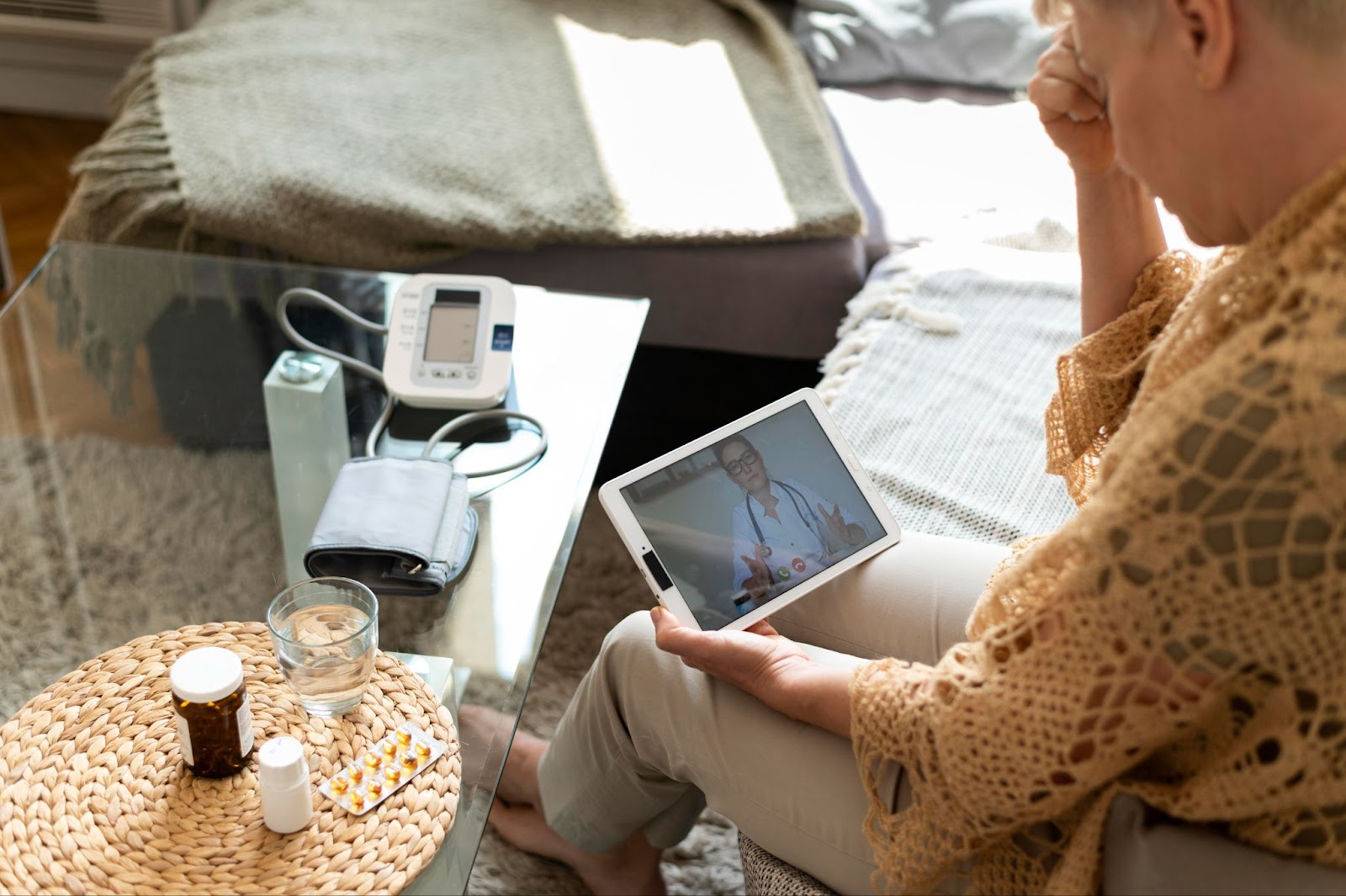In recent years, telehealth has grown rapidly, becoming a key part of healthcare in areas such as nursing, therapy, and long-term condition management. This guide will explain how telehealth works, the types of services it offers, its benefits and drawbacks, and how both patients and healthcare providers use it in everyday practice.
What Is Telehealth?
Telehealth uses digital tools like smartphones, computers, and wireless devices to deliver healthcare services and share clinical information remotely. It connects patients and providers without needing in-person visits, making care more accessible. Unlike telemedicine, which focuses on clinical services, telehealth also includes non-clinical elements like education and administrative support. Key components include video consultations, remote monitoring, patient education, and mobile health apps. It’s used in both clinical settings such as reviewing patient data remotely and non-clinical ones, like virtual wellness coaching. It’s vital to note that the telehealth business model continues to transform how healthcare is delivered across various fields.
How Does Telehealth Work?
Telehealth starts with online registration and patient consent through a secure platform. Appointments are scheduled digitally, with visits conducted via video, phone, or text. Providers assess, diagnose, and may treat patients remotely, offering prescriptions or care plans as needed. A smartphone, tablet, or computer with a reliable internet connection is required. Patients must join on time and share accurate information, while providers manage communication and documentation. A HIPAA compliant telehealth platform ensures privacy and meets legal care standards.
What Are Telehealth Services?

Telehealth services cover a wide range of medical and wellness care delivered remotely. Common types include:
- Primary Care Visits: Routine checkups, minor illness evaluations, and general health concerns are handled through virtual appointments.
- Mental Health & Counseling: Therapy sessions, psychiatric evaluations, and ongoing mental health support via secure video or phone calls.
- Prescription Management: Medication reviews, refills, and adjustments are coordinated remotely between patient and provider.
- Follow-Up Care & Specialist Consults: Post-treatment check-ins and access to specialists without needing a physical referral visit.
- Chronic Disease Management: Ongoing monitoring and guidance for conditions like diabetes, hypertension, or asthma.
- Nutritional Counseling: Virtual sessions with dietitians to support healthy eating and weight management goals.
- Physical Therapy Check-Ins: Guided exercises, recovery updates, and progress tracking conducted through video calls.
What Is Telehealth Nursing?
Telehealth nursing is the delivery of remote patient care by licensed nurses using digital technology. It allows nurses to assess, support, and educate patients without being physically present. Key duties include:
Triage – Evaluating symptoms to determine the urgency of care.
Health Coaching – Guiding patients on lifestyle changes and wellness goals.
Chronic Care Follow-Ups – Monitoring long-term conditions like diabetes or heart disease.
Patient Education – Explaining treatments, medications, and care plans.
Telehealth nurses work through platforms or call centers, providing care coordination, follow-up, and answering patient questions. They also help with patient monitoring, medication adherence, and post-hospital recovery. As virtual care expands, telehealth nursing plays a critical role in improving access while aligning with evolving telemedicine payments models.
Benefits of Telehealth

The main benefits of telehealth include:
- Improving access to care, especially in rural or underserved areas
- Cutting travel time and costs for patients
- Speeding up responses for minor issues and follow-ups
- Enabling flexible scheduling and wider provider reach
- Supporting and promoting continuous care and chronic condition monitoring
Challenges and Limitations of Telehealth
Telehealth depends heavily on stable internet access and patient comfort with technology, which can limit its use for those lacking digital literacy. It’s not suitable for all medical situations, especially emergencies or cases requiring physical examinations. Regulatory and licensing rules vary across states or countries, creating barriers for providers offering remote care. Reimbursement policies differ by payer and region, and not all healthcare systems have fully adopted compatible platforms. Additionally, all telehealth services must meet strict security standards, including HIPAA compliant telehealth requirements, to protect patient privacy.
Telehealth vs. In-Person Care
Telehealth offers remote care through digital tools, making access faster and more convenient. It’s effective for follow-ups, mental health, and chronic condition management. However, it can’t replace the hands-on exams and immediate testing available with in-person care. Emergencies, surgeries, and complex assessments still require physical visits. To bridge these gaps, hybrid care models are emerging, combining virtual and in-person services to improve flexibility, maintain care quality, and ensure patients receive the right type of care when needed.
Common Telehealth Use Cases
Telehealth is widely used for follow-up care after hospital discharge, helping patients recover safely at home. It supports ongoing management of chronic conditions such as diabetes, hypertension, and asthma through regular remote check-ins. Providers can also handle medication adjustments and renewals without in-person visits. Mental health services, including therapy and counseling, are commonly delivered virtually. Additionally, telehealth enables preventive screenings and lifestyle counseling, making it easier for patients to stay proactive about their overall health.
Is Telehealth Covered by Insurance?
Telehealth coverage varies across payers. Medicare and Medicaid expanded benefits during the COVID-19 pandemic and continue to offer broad coverage for many virtual services. Private insurance plans have also increased reimbursement for telehealth, although specifics depend on the insurer. Many policies now include video visits, mental health counseling, and chronic care management. Still, coverage can differ by state and provider, so it’s essential to confirm with your insurance plan and healthcare provider to understand your benefits and any out-of-pocket costs.
Telehealth Technology and Platforms

Telehealth platforms use tools like video conferencing, electronic health record (EHR) integration, and wearable data tracking to support virtual care. Secure systems feature encryption, user authentication, and mobile compatibility to protect patient data and ensure ease of use. Patient portals enable appointment scheduling, secure messaging, and access to health records. These platforms also integrate with billing systems, clinical workflows, and telemedicine payments, streamlining administrative tasks and making virtual care more efficient for both providers and patients.
Telehealth Business Model Overview
Telehealth operates under two main models: business-to-consumer (B2C), where services are offered directly to patients, and business-to-business (B2B), where providers partner with clinics, employers, or insurers. Revenue can come from subscriptions, per-visit fees, employer-sponsored plans, or insurance-integrated payments. Each approach has unique advantages but also faces challenges, including scaling operations, navigating multi-state licensing, ensuring regulatory compliance, and competing in a growing digital health market. Successful models balance accessibility, quality care, and sustainable financial structure.
Regulatory and Privacy Considerations
Telehealth must comply with strict regulations to protect patient information. In the U.S., HIPAA governs data privacy, requiring secure communication, informed patient consent, and proper handling of medical records. Providers must use certified, encrypted platforms and maintain detailed documentation for each virtual visit. Internationally, laws like the GDPR in Europe set additional standards for data protection. Compliance ensures trust, legal safety, and ethical delivery of digital healthcare across various platforms and regions.
The Future of Telehealth
Telehealth is rapidly evolving with the integration of AI and virtual assistants, enhancing diagnostics, triage, and patient engagement. Remote patient monitoring and connected devices are becoming more common, allowing real-time tracking of health data from home. As platforms become more advanced, telehealth services are expanding across borders, offering global access to care. Ongoing policy reforms and continuous innovation in digital health technology are setting the stage for telehealth to become a permanent, scalable part of modern healthcare.
FAQs
What is telehealth used for?
It’s used for remote diagnosis, treatment, education, follow-ups, and ongoing care across many medical specialties.
What is telehealth nursing?
It’s a nursing specialty that provides virtual care, patient education, and chronic condition support via phone or video.
Can telehealth replace in-person visits?
It complements care but does not replace in-person visits for serious or physical examinations.
What is required for a telehealth visit?
A device with internet access, a private space, and access to a secure platform provided by your healthcare provider.
Are telehealth visits secure?
Yes, when conducted on a HIPAA compliant telehealth platform that protects patient data.
Is telehealth more affordable?
In many cases, yes, it reduces transportation costs and time while offering flexible pricing models.
References
Lifewaysmi: Everything You Need to Know About Telehealth?
https://www.lifewaysmi.org/covid19-blog/everything-you-need-to-know-about-telehealth
MedBridge: Telehealth 101: Everything You Need to Know
https://www.medbridge.com/blog/telehealth-101-everything-you-need-to-know
Herzing University: 3 Things You Need to Know About Telehealth
https://www.herzing.edu/blog/3-things-you-need-know-about-telehealth
Telehealth: Why use telehealth?

Leave a Reply